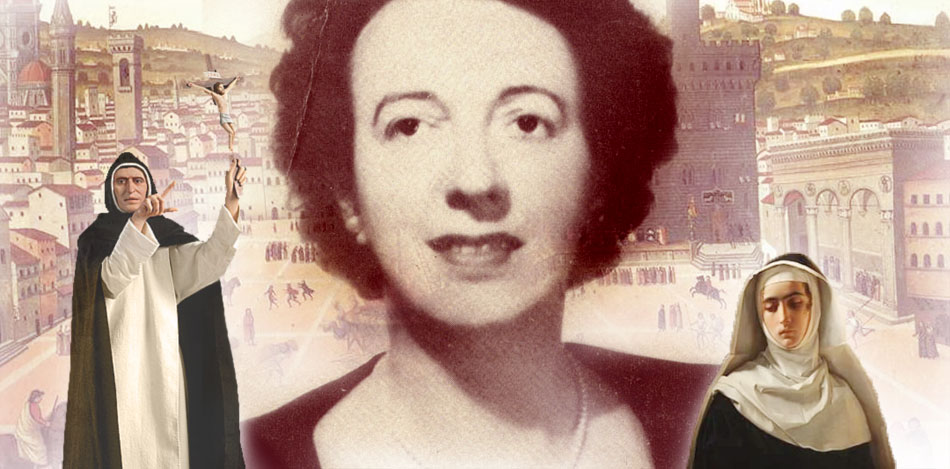Taylor Caldwell: A Journey Into The Past
 by Jess Stearn
by Jess Stearn
Taylor Caldwell, the famous English-born novelist, had just turned 70 when she began to speak to her friend, author Jess Stearn, about reincarnation.
“The conversation had not developed out of thin air,” Stearn wrote. “Janet Taylor Caldwell had toyed with the idea of survival for years and her interest was undoubtedly quickened by the recent death of her husband Marcus Reback to whom she had been married for 40 years.”
Marcus died on August 13, 1970, after a lingering illness and a final two weeks in coma during which the doctor had said he was clinically dead. Janet was inconsolable and fell into profound despair which became chronic depression. Despite her wealth and fame she felt her life had been “a monstrous, painful, agonizing affair. . . .”
In this mood she told Stearn she’d like to be regressed, although she had misgivings as to whether “past lives” were proof of reincarnation, genetic memory or simply evidence of fertile imagination. She also doubted that she could be hypnotized. Stearn suggested her motive for seeking regression through hypnosis was to seek reassurance of survival but she responded, “No, I gratefully look forward to oblivion but I must be sure of it.”
Stearn’s misgivings concerned Janet’s hearing problem. He felt she would be a difficult subject because she has only five percent hearing in her right ear and none in her left. However, she is adept at reading lips and she was not to be put off. They arranged for her to leave her home in Buffalo and join Stearn in Los Angeles. In the meantime, Stearn sought a Hollywood hypnotist to consult with Janet. In sessions held in Stearn’s home Janet Taylor Caldwell first emerged as Jennie McGill, young scullery maid to the 19th-century novelist George Eliot. Later, from her “subconscious memories,” Janet dredged up the life of an Inca princess, a Greek student of Hippocrates and a life between “incarnations” on a mysterious planet called Melina.
Out of these sessions came Jess Stearn’s book, “The Search for a Soul: Taylor Caldwell’s Psychic Lives”, and a tantalizing explanation for the novelist’s uncanny knowledge of ancient and modern medicine, day-to-day life in biblical times and numerous other subjects she never has studied nor researched but which are accurately treated in her novels.
Taylor Caldwell learned the content of the tape-recorded sessions only when she read Jess Stearn’s book in manuscript form. She agreed to write an epilogue in which she concludes:
“The reader must make his own judgments about the theory of reincarnation and the stirring material in this book. I have made my own judgment. I am still the skeptic of skeptics. . . .” Yet. . .
Italy fascinated Taylor Caldwell. She visited that land of violent history not only as a curious traveler but in dreams that bordered on nightmares.
While she didn’t attribute it to reincarnation, a constant dream of another life, of being someone else, haunted her waking moments for years. “I first had this dreadful dream,” she once told me, “when I was about three years old and still living in England. I dreamt I was standing at a small open casement window in a very high building like a tower, and I was looking down, with anguish, on a roof below the casement which was covered with dirty red tiles. The sky was a cold dull white and the sea of roofs beyond was all crowded and jostled red tile and seemingly spread out for miles. In the distance I saw a narrow river and several ornate stone bridges crossing over it. I felt not like a child of three but like a mature woman, say about the middle 20’s, looking about the same as I did when I was [in this life] in my middle 20’s.”
There were no such red tiles on roofs in England, as she knew, and she had the definite impression of a Mediterranean locale—Spain or Italy perhaps.
In the dream she had a limited view of the unnamed city, since she was looking at it from between strong iron bars.
“I was in a sort of icy stone cell, over the city, with only a cot, a table and one chair in it, and there was a wooden door at the rear. I knew the door was bolted and that I was a prisoner in this city I knew well and in which I had lived and been born. I knew that outside the locked door was a narrow winding staircase of stone. Then I heard footsteps on the stone and I knew who was approaching. I knew that in the company there were three men in strange costumes and one was a man I knew very well. I knew his costume in that awful dream and now I know it was the white habit and hood of a Dominican monk (called Black Friars from a black mantle they wore for preaching).
“All of them were familiar to me and I knew why they were coming up the stairs—they were going to torture and kill me. I heard a key grating in the lock and turned to the window again in despair and I knew the only way to escape those men was to throw myself out of the window. So as the door opened I threw myself down onto the sloping roof, very high over the teeming narrow street, with relief and even joy. Then as I rolled down that cutting tilt of tiles all memory was blanked out and I woke up screaming in my little trundle bed in England.”
The dream recurred frighteningly into her adulthood.
“I dreamt it over and over dozens of times, waking with shudders and despair, yet with relief that I had escaped my enemies. And invariably, there was no change in the setting and nothing to remember after I had almost completed my roll-out.”
As Taylor Caldwell became famous she was able to travel and satisfy a longing to visit the cities of Italy, particularly Florence, whose very name mysteriously seemed to intrigue her.
In Florence she and her husband Marcus were guests of a very old Florentine family, the De Morettis, who went back beyond the Renaissance and the ruling Medicis.
That first evening in the De Moretti home the writer had another strange experience. Before retiring for the night she looked down from her bedroom window into the street below where she saw a large round plaza with many streets streaming into it like the spokes of a wheel. In the center of the empty plaza she saw a tall pillar surmounted by a medieval horseman. “All at once,” she said, “a sensation of utter despondency, fear and foreboding came to me and I pulled the curtains across the window and went to bed.”
When she awakened she went to the window, pulled back the draperies and looked outside. She couldn’t believe it. There was no plaza now, only a small concrete island with a modernistic monument on it.
At breakfast she mentioned the plaza she thought she had seen the night before. Count De Moretti went to his library and returned with a large book. He turned a few pages and showed her the plaza just as she had seen it hours before. There it all was: the prancing horseman high on the pillar, the gloomy shadowed streets and the blank sides of the same buildings she had seen — which had disappeared by morning.
The Count gave her a sympathetic smile. He seemed to know what she was going through. What was this fantasy all about, she asked herself, and how had the Count turned so promptly to a scene out of the Italian Renaissance?
There were to be other surprises that day. The Countess took her guests for a tour of Florence. They went to a spacious museum and Janet was much impressed by the gorgeous grounds, rolling green lawns and massive flowerbeds, set off by a wondrous array of fountains and statues. They entered the musty museum and after a while she was glad of the opportunity to get out in the radiant sunshine and stroll through the gardens again. But the gardens, like the plaza, had miraculously vanished. On the way home the Countess pointed out the handsome stone bridges over the Arno familiar to every Florentine sightseer. One bridge with embossed decorations stood out particularly. “Now, there is something really lovely, that bridge,” she said to the Countess.
She had no sooner made the remark than the bridge, like the plaza and the gardens, faded before her eyes. And that was not all. There in the heart of the city another mirage took place. She was looking at a concrete island in the middle of a street when something occurred that made her doubt her senses. “Before my eyes the island disappeared and there was another small plaza and crowds of people in strange costumes and a whole company of white-robed Dominican monks. In the center of the little plaza a man also robed in white was burning to death on a pile of faggots in the bright sunshine, a small, plump man with a heroic face. Horrified, I said aloud, ‘Savonarola.'”
At Janet’s exclamation the Countess pointed to a statue commanding the square. “Yes,” she said, “and that monument is there in his honor.”
Janet returned to the Moretti home a little shaken but she was in for still another jolt. After dinner she and the Count were alone together in the library and she told him of her latest experience. She could not speak Italian nor he English but they seemed to understand each other perfectly.
Finally he nodded and said with a smile, “You have been here before, long ago. I have known of these things all my life also.”
He brought out the book of engravings and opened at once to the beautiful gardens she had seen at the museum. “These,” he said, “were the gardens of the Medicis.” Then he came to the medieval bridge she had seen over the Arno. “This bridge,” he said, “was swept away and lost at the time of Savonarola in a flood.” There was no need to show her the plaza where the fiery crusader for papal reform, the Fra Girolamo Savonarola, Dominican prior of San Marco, had died a flaming martyr in 1498. She had not only seen the square as it was but the event itself.
Encouraged by the Count’s apparent understanding, she related to him the dream which had troubled her for so long, recognizing now a similarity between the tiled roofs of her dream and many of the older Florentine houses.
The Count nodded wisely, then showed her another engraving of medieval Florence, with the same sort of tall narrow building in which she had dreamed she had been a prisoner. Even the jostled red tiles were there.
The Count did not seem to be the type of person who would believe blindly in reincarnation but he said gravely, “You lived in Florence at the time of Savonarola. You must have been one of his followers and that was why you were condemned to death.”
She was not ready to accept this explanation but the dream, once explained, never repeated itself. However, as long as she stayed in Florence she felt the oppression and melancholy which had afflicted her when she first looked out of her bedroom window. She couldn’t get away fast enough. “We cut our visit short, something my husband did not understand until I told him the story. But the Count seemed to understand. It was no secret to him.”
While Savonarola was one of the haunting figures of history, I never had discussed him with Taylor Caldwell other than to record her bizarre experience. It seemed something of a coincidence that George Eliot (for whom Janet had been a scullery maid in one incarnation) should have dealt with Savonarola in her novel Romola but the novel threw little light on his life.
As we sat around relaxing before the day’s regression, as was our custom, I asked Janet if she had read the novel.
“Oh, no,” she said. “The only thing of George Eliot’s that I ever read was The Mill on the Floss.”
“It is not a very good book,” I said. “I hope she didn’t influence your writings.”
“She didn’t influence me at all,” Janet replied.
“You seem to be hearing well today,” I noted.
She smiled. “I always could hear men better. It’s something about the timbre of their voices.”
“And you’re feeling better?”
“I feel remarkably well. I can’t imagine what the trouble is.”
She gave me a serious look.
“I do hope you are not wasting your time, as you’ll never prove reincarnation by me.”
The hypnotist, always practical, was impatiently checking his watch.
“All right,” I said, “let’s go.”
We trudged up to the study, Janet Caldwell well ahead of us. She was already on the couch when we got there and the session began.
The hypnotist touched her forehead gently, saying, “Close your eyes, we are going back again.” I had a hunch.
“Begin with the Renaissance.”
As she usually did, she opened with a soliloquy, dramatically plucked out of history. Her voice was low, muffled, apprehensive, almost as if she were afraid of eavesdroppers.
“They will kill me, the fiends,” she whispered, “as they killed my master Savonarola.”
The hypnotist and I exchanged glances and he checked the prone figure to make sure she was under. There was no question from her appearance, the limpness of her body and set of her face, that she was in deep hypnosis.
 There was no need to prod her, for she was thoroughly caught up in the past.
There was no need to prod her, for she was thoroughly caught up in the past.
“What does it matter, interrogation and the threats? I know they will kill me. Far, far, the dear roofs of Florence,” her voice rose. “I love my convent and the master. He is a saint of saints, Savonarola. They burnt him alive as they will do to me because I followed him. ‘Heretics,’ they said. We are not heretics.” Her voice quavered prophetically. “There will come another who will purge the Church. This I tell them and they call me a witch. Our Master, if you are in heaven, pray for my soul … I hear them coming up the stone staircase outside this room.” She cupped her ear the better to hear. She was obviously the nun of the dungeon, bravely waiting to die for her allegiance to the fiery prior of San Marco.
She had paused, apparently overcome by emotion, and then continued scornfully:
“There is a lesser around me and the Dominican who dares to call himself Father Alphonso—Father.” She fidgeted restlessly. “The soldiers,” she said, picking up her story. “This time, unless I lie to them, they will kill me. Oh, God, I cannot endure them any longer . . . Ah, Master, I hear your voice . . . Go forth, Christian (speaking to herself). I shall plunge through this window, roll down the roof and be dashed to pieces on the stones below, but I will not let them speak to me again.”
Like Savonarola and Joan of Arc, the creature that she had been feared recanting in the face of the flames and so contemplated her own self-destruction.
She seemed to wander, as if momentarily delirious.
“Oh, Savonarola,” she cried, “you are Estanbul, I know.” She saluted, using one hand, as if greeting her master. “Greetings, my Lord, greetings. I have heard your castigations many times. But I do not follow in delusion, no. Tell me this, pray, my Lord, where is Estanbul now?”
Her voice droned on, “At the last minute I knew that Estanbul was Savonarola. I’ll ask no more. Here, my Lord, your word is law so I ask no more.”
The hypnotist moved to get back to the comprehensible in terms of names and places.
“Where in Italy is the convent?”
As was often the case, she did not answer directly. “Sister Mary Bernard of the cloister of Santa Monica . . . near the third bridge.” There was a catch in her voice.
“They took away my cloak and dressed me in men’s clothes because they said it was not seemly for a nun to follow Savonarola. Oh, my father, do not weep for me. My father, I cannot lie and say that Savonarola deceived. I cannot say, even if I die for it. ‘Comfort, my mother, oh do not plead for me with him. No, I’d rather die than be a liar. Kiss the hands of my grandmother, tell her till we meet in heaven, Holy Mary, Mother of God, full of grace. The Lord is with me, blessed art thou among women and blessed is the fruit of thy womb, Jesus.'”
As we gazed down at her, spellbound, touched by the reverence in her voice, she motioned with her hands as if she were fondling a rosary and then she made the sign of the cross. “Our Father, who art in Heaven,” she said, running through the Lord’s Prayer, and again crossing herself.
“How bright the sky,” she added in a piteous voice, “for I must die.”
She had presented a moving picture of that terrible day of martyrdom in Florence five centuries before. And though it all seemed fantastic in the cold light of day there was no questioning the reality of her experience as it unfolded through her.
While we knew of course what had happened to Savonarola it was essential to rounding out the experience for her to get on with the story. And so the hypnotist asked:
“What happened to Savonarola?”
“What happened to you?”
Her voice was like a dirge. “I killed myself. I threw myself out of the window to escape my torture. The top of the bell tower, the campanile.”
“Tell me of your arrest,” the hypnotist said.
“We followed Savonarola—oh, I cannot speak of it.” Janet’s hands went to her face—and she spoke in a tortured voice.
“We had seen our master burn. He said he had been forced to recant. He had been forced to say he was a false prophet. But we knew he lied under torture and extremia. If he could lie under torture, then it was normal for us. And so we fled. There were two mother nuns who had left also. We worked in Firenze (Florence) as scribes, wherever we could find work to do. There must have been a traitor. I do not know what became of the others. I was taken to the campanile. It was a particular form of torture because it was under the bells. And the bells would start ringing and it would deafen me. I could not sleep or rest . . .” Her voice trailed off. “I think his ideas and thoughts will live. One shall come, I know in my heart, who will take disorder from the Church. He will be human also. He will inspire. The Lord has said, ‘One can cast out one devil, seven return.'”
The dream that had tormented her for so many years had fulfilled itself in every respect in this new flight into the past. She had been a nun, a follower of Savonarola, had watched him burn at the stake and then in despair, rather than take the chance of recanting, she had flung herself to death.
She had several brothers and sisters, older than herself, but only a younger sister, Roselia, survived her.
“She was the last child of my mother—the others died before I was eight.”
“What did your sister grow up to be?”
“I do not know. I died when she was five years old.”
And there we had it. Another harrowing session, another suicide. The regression had corroborated the disturbing dream from Janet’s childhood—although I found incomprehensible the materializations in the street that supported this dream. It could all have been dismissed as pure hallucination were it not for the De Moretti engravings that established the reality of her recollection. And perhaps it still was. . .
Excerpt from The Search For A Soul: Taylor Caldwell’s Psychic Lives
See Part II here.
Posted in Other Topics, Past Life Therapy, Reincarnationwith comments disabled.





